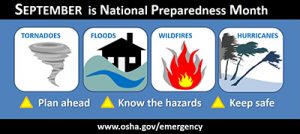A reminder that OSHA has resources to help keep workers safe when faced with natural and man-made disasters.

Hurricane season peaks in September, and wildfires are still burning throughout the Pacific Northwest and from California to Colorado. OSHA urges employers to be prepared to keep their workers safe during extreme weather events. The agency’s Emergency Preparedness and Response webpage provides information on protecting workers before and after hurricanes, wildfires, tornadoes, floods, and other natural disasters strike.
Resource, OSHA.gov/emergency
When a hurricane approaches, people tend to prepare based on previous experience, but that is not always accurate.
Here are some examples:
“I live outside of the cone, so I am safe from feeling the effects.”
The cone has nothing to do with impacts, only the average track error of the past five years. 2017’s Irma went up Florida’s west coast, but its wind field grew in size and pushed storm surge onto Florida’s east coast.
“It’s never flooded here before.”
It is not easy to picture 60 inches of rain, but it was one of the biggest stories of Harvey. There is no historical record of that amount, so it is difficult to imagine what it will do.
“We got hit last year and it was a one hundred year storm, so I’m in good shape for the next one hundred years.”
All a hundred year storm means is that you have a one percent chance of it happening to you every single year. That is the same as a 25 percent chance of flooding in a typical 30-year mortgage. You can be hit in back-to-back years or even in the same year.
“A very slight wiggle in the track doesn’t matter.”
That could be true over the middle of the ocean, but not for land. Hurricane Irma proved that. Its wiggle of 30 miles along Florida southwest coast meant the difference between getting only a few feet of storm surge versus 9 feet.
“We went through a Cat 4 and nothing bad happened”
Many people in Key West will tell you Irma was a Cat 4 there. The reality is they only got Cat 1 winds. You had to go 20 to 30 miles away to find the Cat 4 winds. The reality is that you have to understand exactly what you went through and that you may not have seen the strongest part of that storm.
How do we line up perception with reality? The answer lies in social science. A project will soon begin at NOAA’s National Hurricane Center to find ways to better communicate the risk from the hurricane hazards, find out how people are interpreting our products and to make sure everything is actionable. We have to plan for what COULD happen, not what has happened in the past. It is a life and death proposition.
Resources, OSHA.gov
NOAA Weather